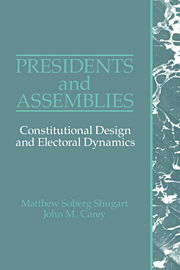Book contents
- Frontmatter
- Contents
- List of tables and figures
- Acknowledgments
- 1 Basic choices in democratic regime types
- 2 Defining regimes with elected presidents
- 3 Criticisms of presidentialism and responses
- 4 The premier-presidential and president-parliamentary experiences
- 5 The constitutional origins of chief executives
- 6 Constitutional limits on separate origin and survival
- 7 Legislative powers of presidents
- 8 Assessing the powers of the presidency
- 9 Electoral dynamics: efficiency and inefficiency
- 10 Electoral rules and the party system
- 11 Electoral cycles and the party system
- 12 Electoral cycles and compatibility between president and assembly
- 13 Conclusions
- Appendix A Electoral rules for one-seat districts and coalition-building incentives
- Appendix B Theoretical explanation for models predicting number of parties in presidential systems
- Bibliography
- Index
4 - The premier-presidential and president-parliamentary experiences
Published online by Cambridge University Press: 05 June 2012
- Frontmatter
- Contents
- List of tables and figures
- Acknowledgments
- 1 Basic choices in democratic regime types
- 2 Defining regimes with elected presidents
- 3 Criticisms of presidentialism and responses
- 4 The premier-presidential and president-parliamentary experiences
- 5 The constitutional origins of chief executives
- 6 Constitutional limits on separate origin and survival
- 7 Legislative powers of presidents
- 8 Assessing the powers of the presidency
- 9 Electoral dynamics: efficiency and inefficiency
- 10 Electoral rules and the party system
- 11 Electoral cycles and the party system
- 12 Electoral cycles and compatibility between president and assembly
- 13 Conclusions
- Appendix A Electoral rules for one-seat districts and coalition-building incentives
- Appendix B Theoretical explanation for models predicting number of parties in presidential systems
- Bibliography
- Index
Summary
INTRODUCTION
Before proceeding with our analysis of the relationship between presidents and assemblies more generally, we now consider the performance of premier-presidential government as well as a few systems that we deem president-parliamentary. Such a task is necessary in order to illustrate more clearly the nature of the regime types, and their distinction from both presidentialism and parliamentarism. This is so particularly because premier-presidentialism and president-parliamentarism have been discussed infrequently in the comparative literature, and may be unfamiliar to many readers. When students of democratic institutions have spoken of premier-presidentialism (what others have called “semipresidentialism”), they have rarely shared a specific, common idea of its institutional structure. And, of course, regimes that we define as president-parliamentary have been described a number of ways: as presidential, semi-presidential, parliamentary, and as hybrids. In Chapter 2, we provided definitions that we believe are exhaustive and generalizable for all these regime types. We begin here with a general discussion of the thorniest institutional problem that is, in effect, built into premier-presidential government – the possibility of a divided executive.
Where the president and the cabinet are of opposing parties or blocs, premier-presidential government faces a challenge somewhat similar to that of presidentialism under divided government. The specific tensions among political adversaries, the dangers to regime stability, and the potential means of resolving those threats, however, are all different under premier-presidential and president-parliamentary as opposed to presidential systems.
- Type
- Chapter
- Information
- Presidents and AssembliesConstitutional Design and Electoral Dynamics, pp. 55 - 75Publisher: Cambridge University PressPrint publication year: 1992



